
Yamaha YZF-R3 Discontinued, To Be Replaced With BS-IV Variant
- Apr 12, 2017
- Views : 7175

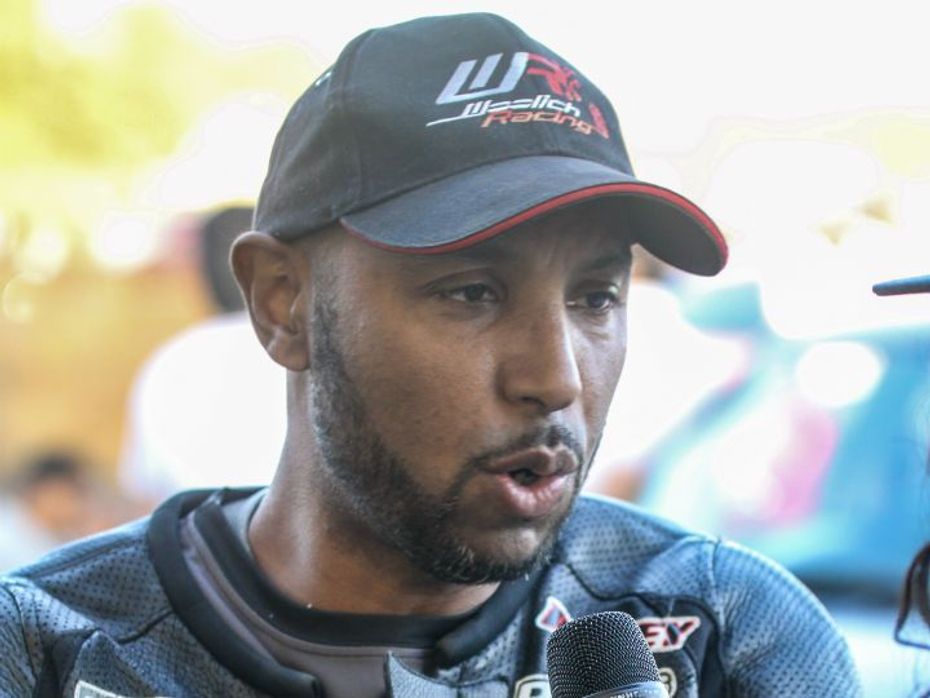
The Man:
Born to a father who was a motorcycle stunt rider and a mother who was a biker herself, Ricky Gadson started drag racing at the age of nine. That's when I barely understood motorcycles. He made a name for himself in the underground drag scene in Philadelphia and was making good money in street races but was quick to realise the risks involved and turned professional.
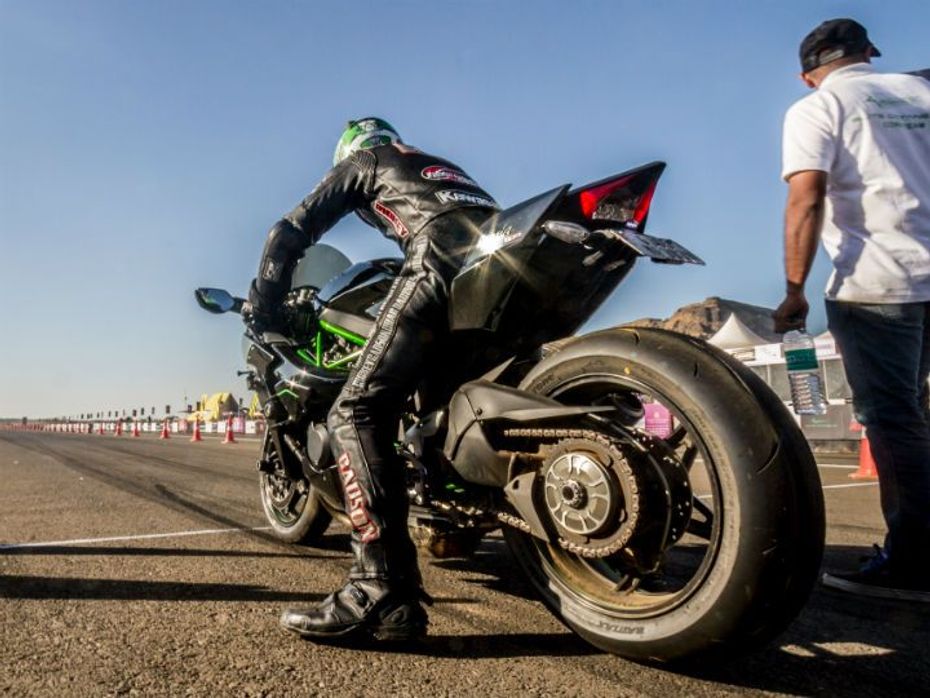
That was back in 1991, and since, there has been no turning back - Gadson has won over 200 races in the past two decades apart from being crowned world champion 11 times. He thus outnumbers the likes of Valentino Rossi and Michael Schumacher in terms of championship wins, and it's a shame drag racing isn't even remotely as popular as MotoGP and F1! He is arguably the quickest there is when it comes to quarter mile runs on a motorcycle, and we couldn't have asked for a better coach to learn about honing our 0-400 metre skills.

Learning the Basics:
A theory session awaited us before we hunched over our motorcycles looking at the 'Christmas Tree' lights. Basics included unlearning what we had been doing, to learn the tricks better. Gadson calls it “deprogramming” and I was indeed all ears as he told us that mental concentration is the most important aspect of any form of racing. The rider has to first distance himself from distractions and focus on the task at hand.
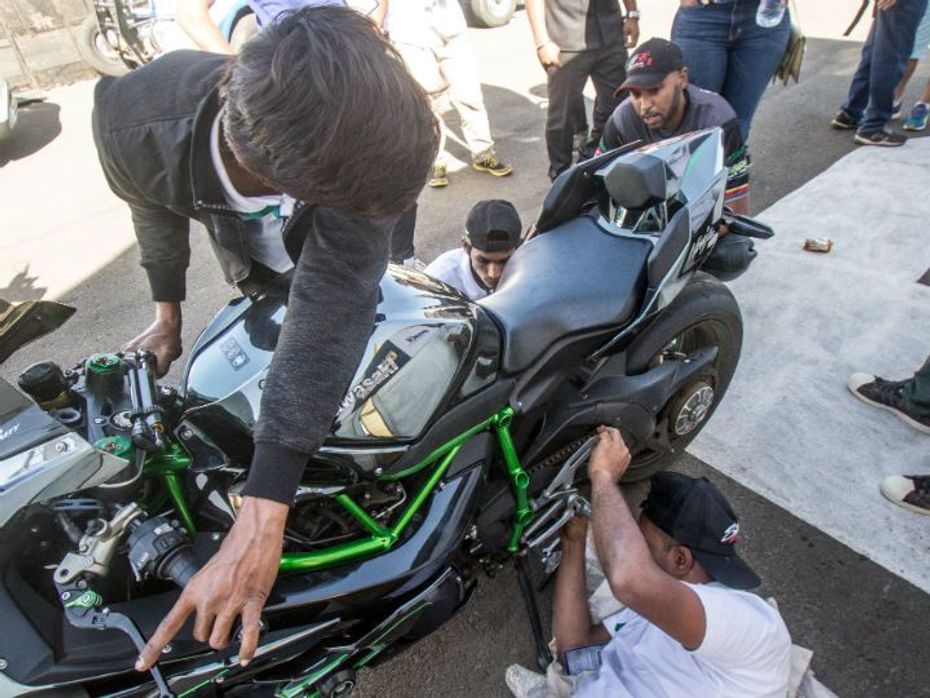
Then comes the motorcycle. Checks before a run include ensuring the cotter pin, drive chain, brakes and engine oil levels are good to take on the stress that the motorcycle goes through over the course of 400 metres. The distance may not sound like much, but launching a motorcycle in a way that all the power produced by the engine is harnessed perfectly (with minimal losses by way of a wheelspin or a wheelie) puts a lot of stress on the aforementioned parts, while repeated runs can cause engine oil to heat up significantly.
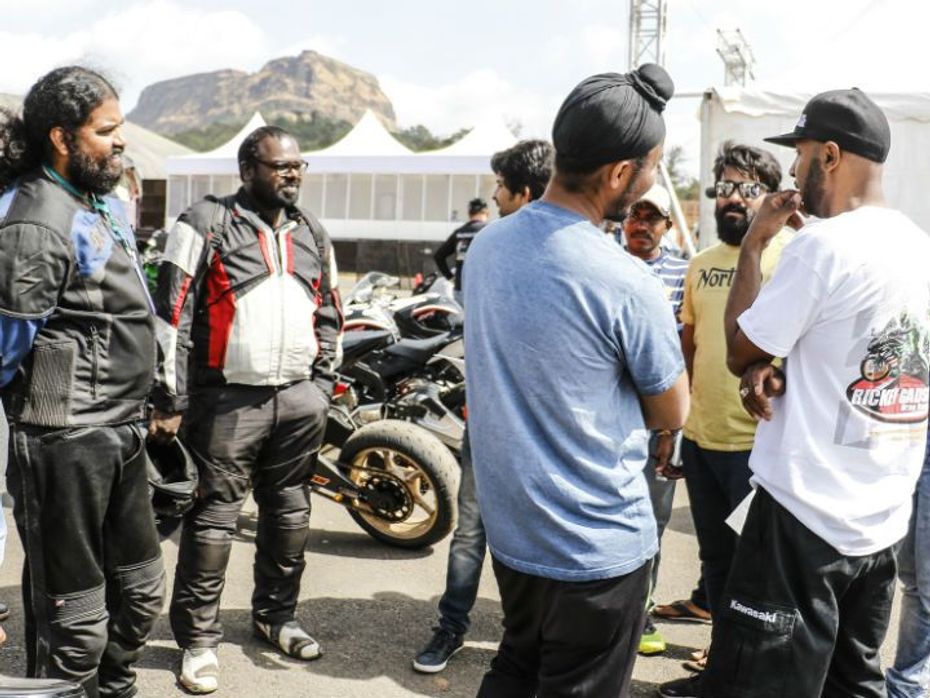
Gadson says one of the most important checks, though, is tyre pressure. Every single psi matters, we were told, and it is of utmost importance to ensure pressures are best suited to track conditions. Apart from that, adjustment of the clutch lever is extremely important too, to ensure you have the right amount of bite from the lever for the perfect engagement of the clutch when the motorcycle is launched.
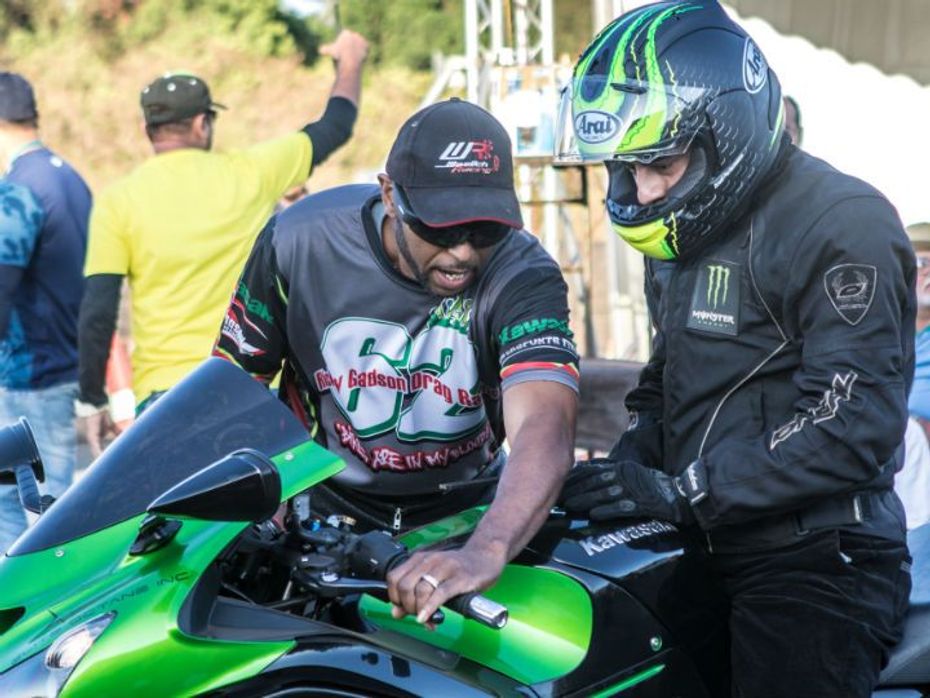
Final Check:
Safety is of utmost important and our riding gear was scrutinised before we entered the drag strip. We were run through basics of pre-staging and the first part was track positioning, which meant walking down the track, which in our case was an airstrip, and looking for bumps or undulations. At speeds close to 200kmph even the smallest of bumps can unsettle the bike.
Once the race line was fixed we were taught “staging” which is a kind of prep before the actual race. First part of this was a burnout, which looks cool and serves two purposes. A burnout heats the rear tyre for better traction and also cleans the centre of the tyre to offer you a cleaner surface to offer maximum grip levels.
Next up was finding the friction point of the clutch – this is the moment where the bike tries to jerk ahead when the lever is depressed. It is also important to always push your bike to the starting line with your feet and never use the clutch as you may lose the friction point in the process.

Time to drag:
Body positioning is of utmost importance for a good launch and a good timing. You need to lean as far forward as possible and stay as low as possible, pressing down on the handlebars. This is important to weigh the motorcycle's front end down, to avoid a wheelie or the front wheel lifting off. This also helps ensure the front gets maximum traction as the rear weighs down due to the power being sent to the rear, and lightens the front end consecutively.
Both feet should be off the bike and only the toes should be on the ground and not the entire foot, with the knees slightly bent and feet pointing outside. According to Gadson “the rider’s left hand should be married to his right hand." This means clutch disengagement and throttle engagement have to be simultaneous. As easy as it sounds, getting this nailed to perfection takes time and patience.
Once you get off the line and manage the balance between throttle and clutch, the next step is to keep the body steady and bring both the feet together. It is also important to duck down for better aerodynamic efficiency and lift yourself up only while braking.
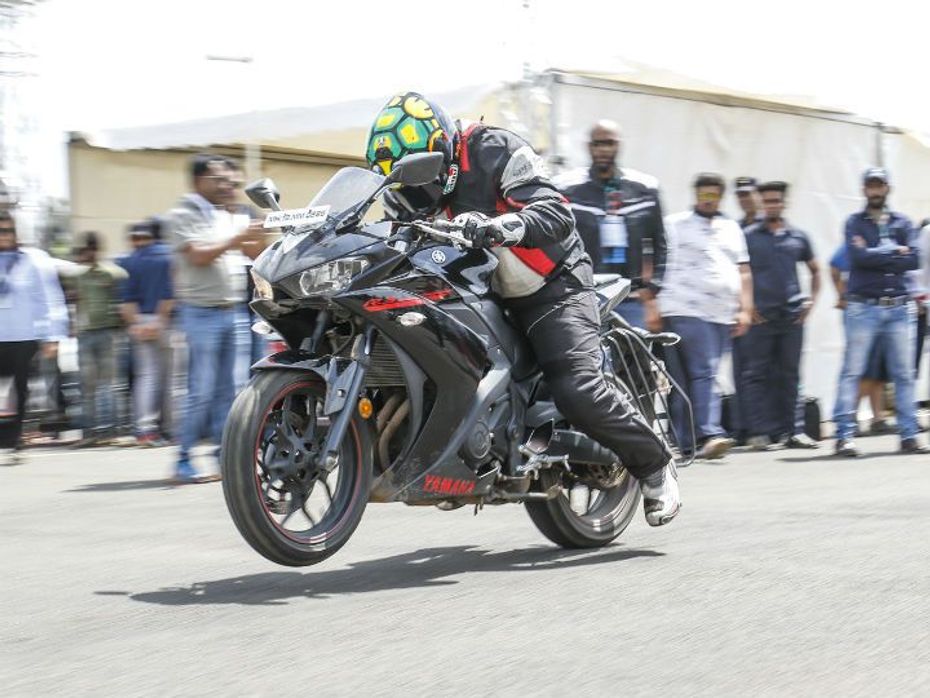
Gadson also stressed on the fact that the rider has to tune in with his motorcycle and should be able to identify what revs the engine is at from the sound. This is very crucial as the rider has to look at the tachometer only when the engine is approaching its redline, for a perfect shift, and concentrate on the track at all other times.
My weapon of choice was the Yamaha R3, which is on a long term test with us. It sure felt a tad small in the company of superbikes like the BMW S1000RR and Suzuki Hayabusa but the lower displacement and power output was in fact a boon to help me learn better without scaring myself silly.
After my initial run with the revs held at 5000rpm for the launch, Gadson suggested I hold the revs at 6000rpm and later asked me to launch at 9000rpm! He was happy with my body position and egged me to weigh down the front more and try to reduce the wheelie. Once on the go you need to be smooth with the throttle.
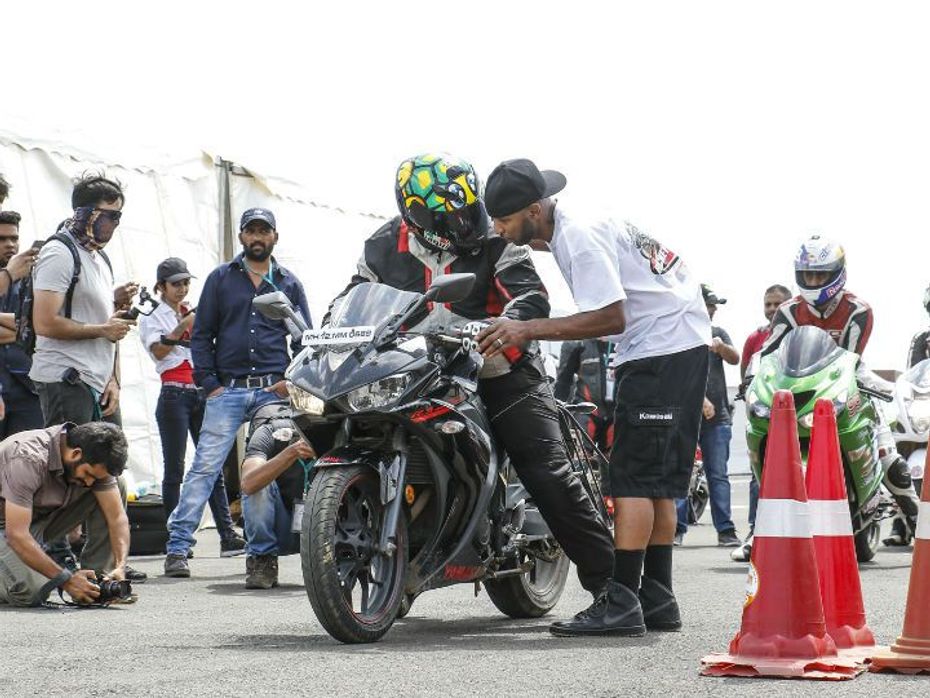
The R3 didn’t wheelie in 2nd or 3rd gear unlike most of the superbikes but Gadson told us the best way to avoid mid-run wheelies is to roll off the throttle ever so slightly to bring the front down and open it again. It is important that both wheels stay in contact with the tarmac for good traction and quicker forward progress as precious milliseconds are lost each time the front wheel rises above the ground.
After every run, Gadson would have a chat with each rider and pinpoint the areas where the particular rider could make improvements to go faster. It was this attention to detail that motivated me to push harder and overcome my fears. Our runs were not being timed but I could feel myself getting quicker and I also realised I was able to achieve higher top speeds at the finish line.
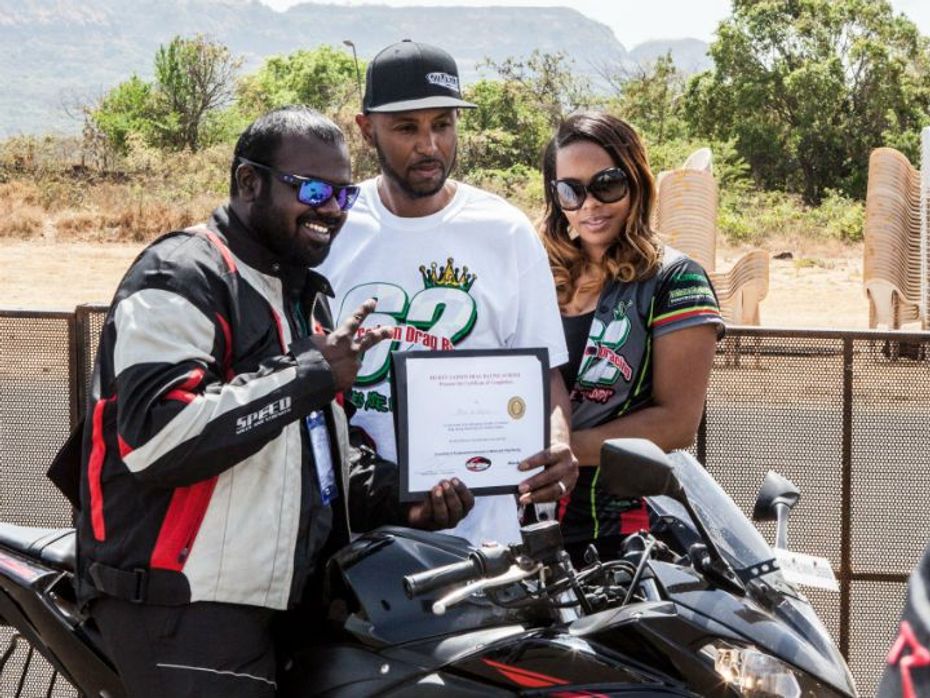
The feeling of being able to launch a motorcycle correctly and nail every upshift perfectly was a big high in itself. The rush of adrenaline helped me reaffirm my belief that drag racing may be about 10 seconds or less, but a perfect launch followed by perfect gear changes in those 10 seconds can be a lot more satiating than several other forms of motorsport.
The drag school was a great learning experience and I was glad I have been coached by the man who is the best in the business. The fee of Rs 30,000 is on the steeper side but the learnings are priceless. I also realized that Rickey Gadson had indeed shown us the direction but how far we travel in the direction is upon us and in the end, it is practice that makes a man perfect.

Yamaha YZF-R3 Discontinued, To Be Replaced With BS-IV Variant

Yamaha R3 Recalled For The Second Time In India

Yamaha Recalls 902 Units Of YZF-R3 In India

2015 ZigWheels Awards: Entry-level Performance Bike of the Year...

MotoGP champion Jorge Lorenzo to ride Yamaha R3 at BIC

Yamaha YZF-R3 Special Coverage

Yamaha YZF-R3: 7 things to Know

Yamaha R3 launched at Rs 3.25 lakh

Yamaha R3 India launch today
 Mahindra Scorpio N
Mahindra Scorpio N
 Royal Enfield Classic 350
Royal Enfield Classic 350
 Royal Enfield Hunter 350
Royal Enfield Hunter 350
 Toyota Fortuner
Toyota Fortuner
 Hyundai Creta
Hyundai Creta
India's largest automotive community
 Maruti Brezza
Rs. 8.34 Lakh
Maruti Brezza
Rs. 8.34 Lakh
 Maruti FRONX
Rs. 7.51 Lakh
Maruti FRONX
Rs. 7.51 Lakh
 Maruti Grand Vitara
Rs. 10.99 Lakh
Maruti Grand Vitara
Rs. 10.99 Lakh
 Mahindra Scorpio
Rs. 13.61 Lakh
Mahindra Scorpio
Rs. 13.61 Lakh
 Toyota Innova Crysta
Rs. 19.99 Lakh
Toyota Innova Crysta
Rs. 19.99 Lakh